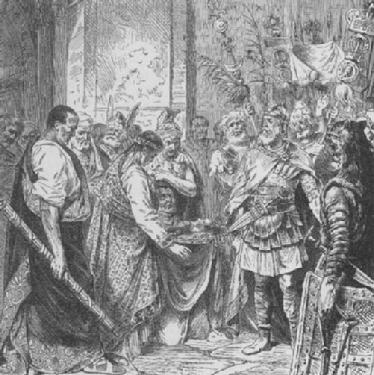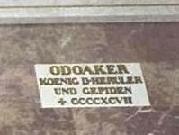Odovacar (Odoacer), The Heruli, and The Fall of the Western Roman Empire
|
 |
| Odoacer Stands Victorious |
|
>
>Is history mutable, as George Orwell proclaimed
in "1984"? Of course it is. History is as
changeable as any ardent advocate might be
able to convince others to believe. That
statement is nonsense, of course. History is not
really mutable; the vast majority is, in fact,
simply lost. Even so the historians among us
seem to have a desire to alter the interpretation
of the incredibly few facts or myths that have survived.
One of my favorite statements on history was made by an English historian, Edward P. Cheney, in 1904. Cheney was speaking of Britain circa 550 CE, during the Anglo-Saxon invasions. Mr. Cheney noted: "The facts, names, and dates given in the early chronicles are, however, fragmentary, confused, and uncertain. These chronicles were written in much later times, and give us at best only the dim outlines of the process of settlement of these newcomers into Britain." Mr. Cheney is stating what I believe. We are lucky to have the tiny fragments that remain. The question is how far can we go in drawing truthful inferences from those fragments? The absolutist is on dangerous ground at all times.
|
 |
| Plaque from Walhalla outside Donaustauf |
|
In my first statement I asked is history mutable? Why would anybody make a deliberate attempt to alter the course of a historical event? To the point, what if the question involves a historical event such as the fall of the Western Roman Empire in 476 CE based on a paucity of original documentary evidence redefining a historical occurrence once thought firmly fixed. There are several possibilities as to why one would seek to bring about such a change, including attaining personal gain through attaching an altered event to oneself and one's reputation, or simply to correct a mistake in history that the writers of the past have somehow overlooked.
For more than fifteen hundred years the historical sources referred to the Germanic warrior who dethroned the last Roman emperor in the west, Romulus Augustus (Augustulus), as Odoacer, or Odovacar, usually referring to this man as the King of the Heruli people. Italy, from the year 476 CE until 493 CE was named in many sources as the Kingdom of the Heruli. Maps were created, especially in the 19th and early 20th Century, which labeled Italy in that period as such. In the most recent historical maps the once former Kingdom of Heruli has now become the Kingdom of Odoacer (Penguin Maps of Medieval History, 1961).
|
After the midpoint in the 20th century we also find 1960's literary works, such as the Time-Life Books series, Great Ages of Man -Barbarian Europe, naming Odovacar as a "leader of uncertain Germanic origin." This was followed by a deliberate non-mention of any role for the Heruli tribe. The Kingdom of the Heruli had, in effect, been erased from history. Concurrently perhaps with this event another seed change had arisen. All of a sudden Odovacar's lineage was now perfectly understood, accept for his mother of whom nothing is known. Odovacar was described as the son of the king of the Sciri Tribe. In at least one source, the government in Italy for seventeen years after the deposing of the emperor was ruled by a so-called Sciri Royal Family, headed by Odovacar. Arnulf Krause, in his book Die Geschichte Der Germanen, states that Odovacar was "der Sohn des Koenigs der Skiren, eines eher unbekannten germanischen Volkes aus den osateuropaeischen Steppen" and that "Odoaker befehligte eine bunt gemischtes Truppe aus Skirren und anderen Germanen." Any significance of the formerly dominant Heruli to the historical mix is perhaps included under the designation "anderen Germanen," other German warriors. But the importance of the Heruli and their support for Odovacar --whoever and whatever he was -- is probably the one thing I would like to state with certainty about the event. In every historical myth there is a kernel of truth. As to the myths surrounding the fall of the Western Roman Empire those persons called by the name Heruli just may be that singular kernel. I'll try to explain.
Could Odovacar, whatever his tribal origins, have been the commander of -- or a leader who had influence with -- the mercenary soldiers guarding the person of Emperor Romulus Augustus? Command of that guard would be a most significant position from which to overthrow an empire from within. Was this guard composed of Heruli mercenaries and was this the reason the Heruli name came to be associated with the event over the last many centuries? If so, why should this important fact suddenly be cast aside? I propose that it shouldn't and so I choose to look again at the role of the Heruli in the fall of the Western Roman Empire in 476 CE and its aftermath.
One modern source, which advocates the origin of Odovacar as being of the Sciri Tribe, makes a simple assertion of some importance which the author then seems to overlook. This author Herwig Wolfram is Professor of History at the University of Vienna. His book The Roman Empire and Its Germanic People, which I thoroughly enjoyed reading, states that when Odovacar came to Italy, and hence to Ravenna, the seat of imperial power, he was, "followed by numerous Rugian and Herulian bands and most of the surviving Scirians." Professor Wolfram places the Heruli name at the scene of the action in the proper time-frame. That is what historians formerly claimed, but with greater emphasis on the importance of the Heruli to overall events.
There are not many experts on the Late Imperial Roman Army, and I confess I am also not one. However, I do understand military terminology and the uses that are made of military units, especially those of the Imperial Guard, which functioned at that time as the personal bodyguard of the emperor. If these troops revolted or changed allegiance, as they sometimes did, great events happened. The kernel of truth for the history surrounding Odovacar, I believe, lies with a truly vital piece of data, the ancient list of the Imperial Roman Magister Peditum, copied through the centuries by Christian monks. This is the Roman Army's list which names the units of that army, and especially those under the control of the individual named Master of the Foot, the title for the one responsible for infantry and foot guards. On that list there is the name Heruli Seniores, a reference to a unit of the Late Roman Army which was composed of those who called themselves Heruli. There is no such unit for the Sciri or the tribe of the Rugians. There was in fact a specific Roman Army battle shield assigned to the Heruli, a round shield -- a common Germanic-type shield in that period -- that looks a lot like a bulls-eye, with a red outer band, white secondary band, followed by another red band and a white center. There is additional information about this Heruli military unit. It is named as Auxilia Palatina, referring to a palace guard. What does that mean? It means that this particular Heruli formation might have been a Late Roman version of the famous Praetorian Guard, those who stood in the first rank as protector of the emperor. In the Late Roman period the emperor's guard, which had once been composed only of Romans, then Italians, was in 476 CE the purview of Germanic barbarian mercenaries. The Heruli, having the reputation as being the greatest of warriors, were holding this position of honor, along with others. These guard units were the true power behind the throne, and I believe they were front and center in Ravenna. Perhaps this Heruli guard unit, whatever its size, provided the force necessary for Odovacar to assume power. That is why the Heruli name came to be associated with the event and why that name came down in history as central to the Western Roman Empire's fall.
There is a picture, a pen-and-ink depiction by B. Moerlins in Ridpath's History of the World, Volume III, 1901, which highlights a confident Odovacar standing before a chastened and humble Emperor Romulus Augustus and his courtiers. (See above, left hand side.) Odovacar is dressed in all the finery of a Roman Army general officer of the highest rank. Behind him are several long-blond-haired Germanic warriors, they also dressed in imperial military finery, one even portrayed as wearing a wolf's head covering, perhaps a standard bearer. In the mix are several standards, one bearing what might be the emperor's own image. In this scene, one of the emperor's retainers offers Odovacar a crown. For my historical understanding, this is the image and history that has lasted fifteen hundred years, now relegated to an almost obscure point, over shadowed by the events of the soon to come Ostrogothic Kingdom of Theodoric the Great, who would take Odovacars life and his glory as the ruler of the once great Western Roman Empire.
Odovacar has been said to have been an adherent of the Arian faith, a heretical position today in the Christian belief system, which taught Christ was a man, a great teacher, not God. It is not known what the Heruli who served at Ravenna believed. There were Heruli bands fighting as mercenaries under many different commands, from Western Roman to Eastern Roman, to the Goths, to the non-Christian Huns under Attila, and all conflicts in between. Some of them may have converted from their ancient and natural beliefs, becoming Christian Arians, Orthodox, perhaps even Catholic. Then again, sources say that many remained non-Christian. It is the latter that are of crucial interest to myself, but that is the subject for a different article.
Richard Wadsworth resides in Truth or Consequences, New Mexico. He is President of the Sierra County Historical Society and author of two historical novels about antebellum New Mexico, Forgotten Fortress , which tells the story of the first American Army fort in the Apache country, Fort Millard Fillmore, 1851-1862 and Incident At San Augustine Springs, which examines in detail the famous surrender of the United States Army's 7th Infantry Regiment to an inferior force of Confederate Texas troops at San Augustine Springs, New Mexico on July 27, 1861. Richard Wadsworth has also published his most recent series on the Heruli. This series of historical/ fiction takes place within the turmoil of the migration age following the last remnants of the Heruli on their mythical migration back to their northern homelands. For more information on the Heruli series follow the link below.
http://lorasinthe-germania.com
|
|